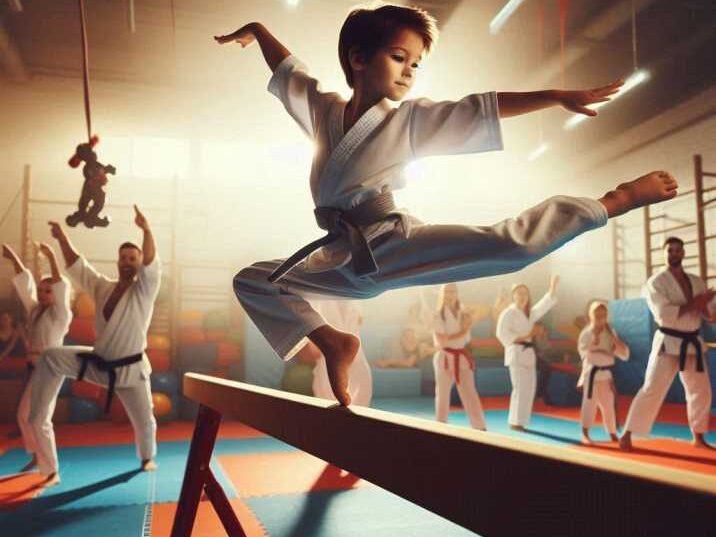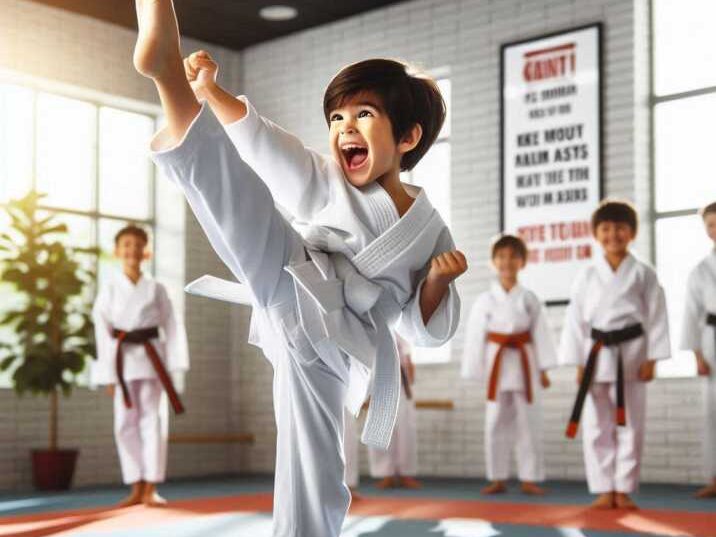Introduction
Table of Contents
Martial arts give kids discipline, strength, and focus. But what if you could add another activity that makes them even stronger and more flexible? That is where gymnastics comes in.
Parents often look for ways to help their kids succeed in martial arts. Gymnastics may not seem connected at first, but it builds skills that directly support martial arts training. From better balance to safer falls the overlap is clear.
This guide explains the gymnastics benefits for martial artists in a simple way. You will see why parents and coaches encourage kids to mix both activities. It can make martial arts safer, more fun, and more rewarding.

What Is Gymnastics for Martial Artists?
Gymnastics is a sport that focuses on body control, balance, strength, and flexibility. Kids practice moves like cartwheels, rolls, flips, and handstands. These skills match perfectly with martial arts.
When children learn gymnastics, they train their bodies to move with precision. In martial arts, this precision is the difference between a strong kick and a weak one, or a safe fall and an injury.
Key Gymnastics Benefits for Martial Artists
Improved Balance and Coordination
Martial arts depend on stance and posture.
In martial arts, every move starts with the stance. If a child’s stance is weak, the rest of the technique will not work well. Good posture keeps the body stable and reduces the chance of falling. Martial arts teachers often spend a lot of time helping kids build strong stances. Gymnastics adds extra practice in body control, making these stances even better.
Gymnastics teaches children how to stay steady while moving.
Gymnastics includes activities like walking on a beam, handstands, and cartwheels. These movements challenge kids to stay balanced even when their bodies are upside down or in motion. When kids master these skills, they learn to control their center of gravity. This training carries over to martial arts when they need to stay steady while kicking or blocking. With gymnastics, balance becomes second nature.
This improves kicks, punches, and defensive movements.
A steady body makes every martial arts move more powerful and accurate. For example, a child who can balance well can kick higher without losing control. Strong coordination also makes punches land faster and with better timing. Defensive skills, like dodging or blocking, depend on quick, controlled movement. Gymnastics helps kids sharpen these reactions, which gives them an edge in martial arts practice and tournaments.
Stronger Core and Muscles
Many martial art styles rely on core strength.
In martial arts, the core is the center of power. Whether it is a punch, a kick, or a throw, the movement comes from the stomach and back muscles. A strong core helps kids generate force without losing balance. It also protects the spine and improves posture, which is key in training and sparring.
Gymnastics builds abdominal, leg, and arm muscles.
In gymnastics, children practice routines that use their whole body. Moves like handstands, pullovers, and floor exercises develop strength in the abs, legs, and arms. Unlike weightlifting, gymnastics builds strength naturally through bodyweight training. This balanced muscle growth helps kids perform better in martial arts without straining their bodies.
This strength supports powerful kicks and stable stances.
A strong core and legs give martial artists more power in their kicks. Stable muscles in the hips and abs make it easier to hold stances for long periods. Kids also learn to stay firm when blocking or defending. With better muscle control, they can strike with precision and stand their ground against opponents.

Better Flexibility and Range of Motion
High kicks and joint locks need flexibility.
In martial arts, techniques like roundhouse kicks or submission locks require the body to move freely. If kids lack flexibility, these moves become difficult or even painful. Flexible muscles and joints make training smoother and safer. This is why stretching is always part of a martial arts warm-up.
Gymnastics stretches and opens the body safely.
Gymnastics focuses heavily on stretching before and after routines. Kids learn splits, bridges, and other exercises that improve flexibility step by step. These movements make the body more open without forcing it. Regular practice reduces stiffness and helps children move with ease in martial arts classes.
Flexible kids move faster and reduce injury risk.
When kids are flexible, they can kick higher and dodge attacks more quickly. Their bodies recover faster after intense training. Flexibility also protects against injuries like muscle pulls or joint strains. This makes martial arts safer and more enjoyable over time.
Safer Falls and Rolls
Martial arts often involve throws and takedowns.
In sports like judo or aikido, falling is a regular part of training. Even in karate or taekwondo, kids may slip during sparring. If they do not know how to fall safely, they can get hurt. This makes learning fall techniques just as important as learning strikes.
Gymnastics teaches safe landings and rolls.
In gymnastics, children practice forward rolls, backward rolls, and controlled landings. These skills teach them how to absorb impact with the body instead of the head. When applied to martial arts, this makes throws and takedowns less dangerous. It also builds trust and confidence during practice.
Kids learn to protect their head, neck, and spine.
Safe rolling and landing techniques train kids to tuck their chin and spread impact. This protects sensitive areas like the neck and back. It also helps them avoid hitting their head on the floor. With these habits, kids can practice martial arts with much lower risk of injury.
Mental Focus and Confidence
Both sports demand attention and discipline.
Martial arts classes require focus on stances, moves, and respect for the teacher. Gymnastics demands the same focus to perform skills correctly. Doing both teaches kids to listen carefully, stay present, and control their actions. These habits carry over into school and daily life.
Kids build confidence by mastering difficult moves.
Learning a cartwheel or landing a flip gives children a sense of achievement. The same is true for breaking a board or earning a new belt in martial arts. Each success builds self-esteem and shows kids that effort pays off. This growing confidence helps them face challenges outside of sports too.
This mental strength transfers directly into martial arts training.
When kids believe in themselves, they perform better in martial arts. Confidence allows them to try new techniques without fear. Strong focus helps them stay calm in competitions or during sparring. Together, gymnastics and martial arts create resilient, confident children.
Possible Risks or Concerns
Parents may wonder about risks. Here are some things to consider:
Overtraining: Doing both sports without enough rest can tire kids out.
When kids train in gymnastics and martial arts back-to-back, their bodies do not get enough time to recover. This can lead to fatigue, poor performance, and even burnout. Rest days are just as important as practice days for growth. Parents should make sure their child has a balanced weekly schedule.
Injury: Advanced gymnastics moves, like flips, may cause sprains if rushed.
If children try difficult skills before they are ready, they may strain muscles or twist joints. This is why supervision and gradual progress are key. Certified coaches know how to introduce advanced moves safely. Proper technique reduces the risk of injuries in both gymnastics and martial arts.
Time Commitment: Both sports require practice. Balance is important.
Martial arts and gymnastics each demand several hours of practice per week. Too many activities can overwhelm kids and cut into schoolwork or rest. Parents should pick training times that fit smoothly into daily life. Balance ensures kids enjoy both sports without stress.
Safety Tips for Parents
Start with beginner-level gymnastics.
Children should first master simple moves like rolls, cartwheels, and basic stretches. These lay the foundation for harder skills later on. Starting slow builds confidence and reduces the chance of injury. Parents should avoid pushing their kids into advanced classes too early.
Choose certified coaches for both activities.
A qualified coach knows proper techniques and safety steps. Certified instructors also understand how to work with kids at different ages and skill levels. This guidance prevents bad habits that may cause injuries later. Parents should check coach credentials before enrolling their child.
Give kids rest days to avoid burnout.
Training every single day can exhaust the body and mind. Rest days let muscles recover and grow stronger. They also keep kids motivated and excited for practice. Parents should plan at least one or two rest days per week.
Make sure kids warm up and stretch before practice.
Warm-ups prepare the body for intense movement by increasing blood flow to the muscles. Stretching improves flexibility and reduces injury risk. A good warm-up can be as simple as jogging, jumping jacks, or light stretches. Parents should encourage this habit before every class.
Encourage hydration and healthy snacks.
Both gymnastics and martial arts burn a lot of energy. Kids need water to stay hydrated and healthy snacks to refuel. Fruits, nuts, or yogurt are better options than sugary treats. Good nutrition helps children stay active and recover faster after training.
Comparison: Martial Arts Alone vs Martial Arts with Gymnastics
| Skill Area | Martial Arts Alone | Martial Arts + Gymnastics |
|---|---|---|
| Balance | Good | Excellent |
| Flexibility | Moderate | High |
| Strength | Strong | Stronger |
| Safe Falling Skills | Basic | Advanced |
| Confidence | Good | Excellen |
Conclusion
Combining gymnastics with martial arts gives kids a clear advantage. It improves balance, strength, flexibility, and safety. Parents who add gymnastics see their children grow more confident and skilled.
If your child already enjoys martial arts, gymnastics can be the next step to unlock their full potential. Support them, guide them, and celebrate their progress. The benefits will last a lifetime.
FAQs
1. Is gymnastics safe for kids who already do martial arts?
Yes, when taught by certified coaches and done at the right level, gymnastics is safe and supports martial arts training.
2. At what age should my child start gymnastics for martial arts?
Most kids can start around age 4–6 with basic movements like rolls and cartwheels.
3. Will gymnastics make my child too tired for martial arts?
Not if you schedule rest days and avoid overtraining. Both activities can balance well.
4. Do all martial arts benefit from gymnastics?
Yes, but sports like judo, taekwondo, and karate benefit the most due to falls, kicks, and stunts.
5. Can gymnastics replace martial arts training?
No, gymnastics supports martial arts but cannot replace the skills of striking, defense, and discipline.


